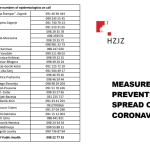
October 8, 2020 – The latest official COVID-19 in Croatia weekly report has been released by the Koronavirus government website, covering September 29 to October 5.
CIPH report for the previous 7 days and daily report for the Republic of Croatia on the 5th of October 2020.
| Tested | Confirmed cases | Active cases | Recovered | Self-isolation | Hospitalized | On a respirator | Deaths | |
| 328 392 (+2233*) | 17797 (+138*) | 1466 | 16031 | 8923 | 326 | 24 (+3*) | 300 (+2*) |
|
| A total of 193 people died in this epidemic wave. Most of the deceased had significant comorbidities or were of advanced age. The average age of the deceased in this epidemic wave is 76.7 years. Ninety – one people died on a respirator. | ||||||||
* in the last 24 hours.
There are currently 24 testing places in the Republic of Croatia that perform RT-PCR analysis and collect samples. All processed samples enter national Croatian Health Insurance Institute platform, which is accessible to all county public health institutes. County public health institutes submit data about positive cases, sources of infection and hotspots as part of their daily reports to the Croatian Institute of Public Health. The Croatian Institute of Public Health collects information about hotspots, hospital treatment of COVID-19 positive persons, COVID-19 positive patients on respirators and the deceased. You can find more about the test centers on the link.
Epidemiological indicators on 5th of October 2020
- Cumulative 7-day rate for the Republic of Croatia: 38,0/100 000
- Cumulative 14-day rate for the Republic of Croatia: 68,6/100 000
- Counties with a cumulative 7-day rate greater than 50/100 000 inhabitants: Krapinsko-zagorska, Ličko-senjska, Međimurska, Požeško-slavonska, Sisačko-moslavačka, Vukovarsko-srijemska
- Counties with a cumulative 14-day rate greater than 100/100 000 inhabitants: Krapinsko-zagorska, Ličko-senjska, Požeško-slavonska, Vukovarsko-srijemska
- Total number of tests in the last week: 32 394
- Share of positive tests in the total number of tests in the last week: 4,8%
- Total number of tests and share of positive tests in total number of tests: 328 392; 5,4%
- The number of new cases in intensive care per 100,000 inhabitants in the last 7 days: 0,46/100 000
- Number of deaths in the last week: 28
- Total death rate per 1 000 000 population: 73,4/1 000 000
Geographical distribution of new COVID-19 cases by counties
In a two-week period from 29th of September to 5th of October all counties recorded new cases of COVID-19 disease. The highest number of new cases are recorded in the City of Zagreb, followed by the Splitsko – dalmatinska and Primorsko – goranska County. The lowest number of new cases were recorded in Istarska and Šibensko – kninska County. The Požeško – slavonska County also has the highest 14-day rate, followed by Ličko-senjska and Vukovarsko-srijemska County.
Figure 1. 14-day rate by counties in Croatia on October 5, 2020.
Epidemic by weeks, from 19th – 32nd week of the epidemic
Table 1 shows the epidemiological indicators by epidemic week. The data shows that one of the most important epidemiological indicators – the rate of confirmed cases and the share of positive ones show a positive trend in the period from 27th to 31st week, while in the 32nd week a slight increase was again recorded. The confirmed case rate has been steadily declining since week 27 when it stood at 47.6 to 31,2 at week 31. The total number of tests has been growing continuously from the 25th week, but at 31st and 32nd week there was a slight decrease in the number of tests compared to previous weeks. The proportion of positive people in total testing also fell steadily, falling from 12.5 in the 26th week of the epidemic to 3.7 in the 31st week to rise again to 4.4% in 32nd week.
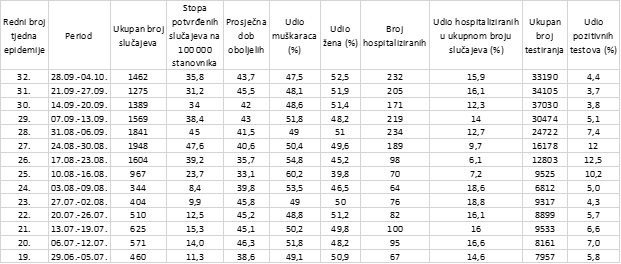
Table 1. Overview of the number of confirmed cases by weeks, from week 19 th – 32nd
Table 2 shows a set of indicators related to the severity of the clinical picture and the characteristics of deaths. The table shows that in the period from 27th to 31st week, there has been an increase, and at 32nd week a slight decrease in the average age of the patients and the number of cases on the respirator, which corresponds to previous findings that older people are more likely to develop more severe clinical forms and higher mortality in older age groups. The death rate in the last 4 weeks shows stagnation.

Table 2. Overview of patients on respirator and deaths by weeks, from week 19th – 32nd
Table 3 shows the incidence of the 7-day rate in the two last weeks with a limit of 50/100 000 inhabitants, which in some countries is taken as one of the criteria in assessing the epidemiological situation. In most counties, the 7-day rate is generally stable or slightly declining, while an increase in the 7-day rate can be seen in counties where outbreaks with a larger grouping of patients have been reported.
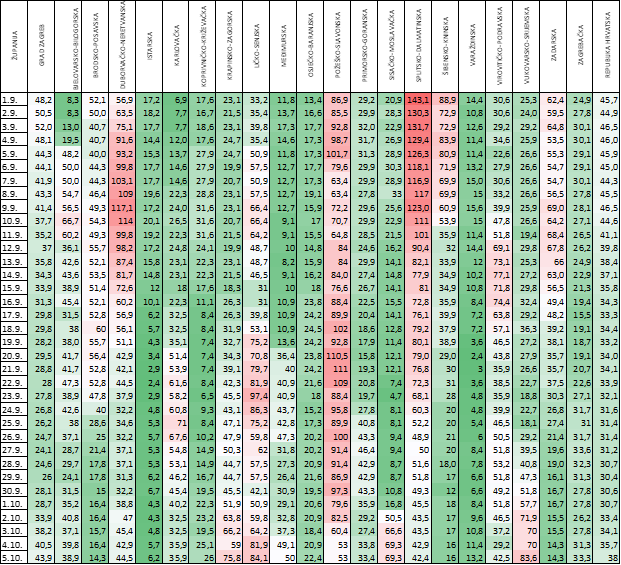
Table 3. Overview of 7-day incidence rates per 100,000 population in the last week
Clinical aspects – Hospitalizations and severity of clinical picture for the period from 29th of September to 5th of October
Figure 2 shows the relationship between the daily number of confirmed cases and the daily number of hospitalized cases. Number of hospitalized cases per day ranged between a minimum of 31 and a maximum of 45, while the share of hospitalized cases in the total daily number of confirmed cases ranged from 12.0% to 32.6%.
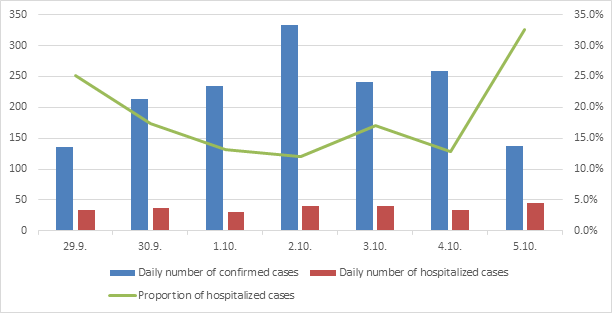
Figure 2. Overview of the daily number of confirmed and hospitalized cases from 29th of September to 5th of October
Figure 3 shows the proportion of hospitalized in the total number of weekly cases. Of the total number of confirmed cases in a given weekly period, 16.8% were hospitalized, which is an increase compared to last week’s 15.2%. In the same period, 19 people were put on a respirator, which makes 1,2% of the total number of confirmed cases.
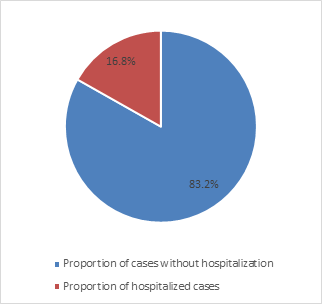
Figure 3. Relation of the total number of confirmed and hospitalized cases (29th of September – 5th of October)
The graph in Figure 4 shows that the slope of the curve of confirmed cases is followed by the curve of cured cases, while the curve of active cases, in addition to some ascending, shows stagnation in certain periods related to the continuation of the first wave of the epidemic in Croatia. After changing the duration of isolation of patients, a sharp decline in the number of active cases is recorded and after that, the number of active cases stagnates.
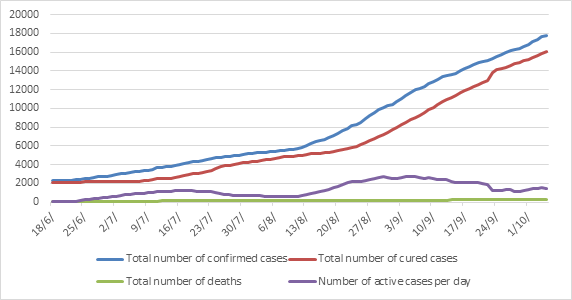
Age-sex distribution of COVID-19 deaths
A total of 193 people died in this wave of epidemics. Most of the people who died had significant comorbidities or were of advanced age. The mean age of the deceased in this wave of epidemics is 76.7 years. Ninety – one people died on a respirator. An overview of the situation is given in Table 4 and Figure 5.
| AGE GROUP | 40-49 | 50-59 | 60-69 | 70-79 | 80-89 | 90-99 | 100+ |
| MEN | 1 | 11 | 20 | 45 | 27 | 8 | 0 |
| WOMEN | 0 | 0 | 14 | 22 | 35 | 9 | 1 |
Table 4. Died people by age and gender in the period from 29th of June till 5th of October
Deaths for the period from 29th of September till 5th of October
In the last week, 28 people died, of which 15 (53.6%) were on a respirator. The distribution by age and sex in the last weeks is shown in Table 5, and by counties in Table 6.
| AGE GROUP | 50-59 | 60-69 | 70-79 | 80-89 | 90-99 |
| MEN | 1 | 3 | 7 | 4 | 2 |
| WOMEN | 0 | 2 | 3 | 4 | 2 |
Table 5. Distribution by age and sex of persons who died in the last week
| County | Number of new cases in the period 29.9.-5.10. |
Incidence of new cases in the last 7 days on 100 000 inhabitants |
Number of deaths in the period 29.9.-5.10. |
Total number of deaths | Total mortality rate at 1,000,000 inhabitants |
| CITY OF ZAGREB | 353 | 43,9 | 6 | 49 | 60,9 |
| BJELOVARSKO-BILOGORSKA | 42 | 38,9 | 1 | 2 | 18,5 |
| BRODSKO-POSAVSKA | 20 | 14,3 | 1 | 6 | 42,8 |
| DUBROVAČKO-NERETVANSKA | 54 | 44,5 | 2 | 15 | 123,7 |
| ISTARSKA | 13 | 6,2 | 0 | 13 | 62,3 |
| KARLOVAČKA | 42 | 35,9 | 1 | 3 | 25,7 |
| KOPRIVNIČKO-KRIŽEVAČKA | 28 | 26,0 | 0 | 16 | 148,5 |
| KRAPINSKO-ZAGORSKA | 95 | 75,8 | 1 | 5 | 39,9 |
| LIČKO-SENJSKA | 38 | 84,1 | 0 | 1 | 22,1 |
| MEĐIMURSKA | 55 | 50,0 | 0 | 0 | 0,0 |
| OSJEČKO-BARANJSKA | 62 | 22,4 | 1 | 27 | 97,4 |
| POŽEŠKO-SLAVONSKA | 36 | 53,0 | 1 | 6 | 88,4 |
| PRIMORSKO-GORANSKA | 95 | 33,4 | 7 | 14 | 49,3 |
| SISAČKO-MOSLAVAČKA | 103 | 69,3 | 2 | 7 | 47,1 |
| SPLITSKO-DALMATINSKA | 190 | 42,4 | 2 | 72 | 160,7 |
| ŠIBENSKO-KNINSKA | 16 | 16,0 | 0 | 7 | 69,9 |
| VARAŽDINSKA | 22 | 13,2 | 0 | 3 | 18,0 |
| VIROVITIČKO-PODRAVSKA | 32 | 42,5 | 1 | 10 | 132,9 |
| VUKOVARSKO-SRIJEMSKA | 129 | 83,6 | 1 | 17 | 110,1 |
| ZADARSKA | 24 | 14,3 | 1 | 9 | 53,5 |
| ZAGREBAČKA | 103 | 33,3 | 0 | 18 | 58,2 |
| TOTAL | 1552 | 38,0 | 28 | 300 | 73,4 |
Table 6. New patients and deaths in the last week and total deaths
Hotspots
Continental Croatia
In the last week, new cases were recorded in all counties of continental Croatia, but mostly in the City of Zagreb, Vukovarsko-srijemska and Sisačko-moslavačka County. The highest 7-day rates on 5th of October were recorded in Vukovarsko-srijemska, Krapinsko-zagorska and Sisačko-moslavačka County. A large increase in the number of patients and a new grouping was recorded in the Sisačko-moslavačka County, where almost all participants in one gathering were positive. These participants also attended various family and public gatherings and a further influx of patients is expected. In Krapinsko-zagorska County, a new large grouping of patients is related to the workplace, but smaller groupings related to the workplace are recorded in several counties. Hotspots related to weddings in Međimurska County and the celebration of the sacraments in Vukovarsko-srijemska County are still active. A smaller hotspot was recorded in the health institution in the City of Zagreb. The disease was also recorded in wards and staff in a home for the elderly in Bjelovarsko-bilogorska, Sisačko-moslavačka and Koprivničko-križevačka County. Some of the patients were imported cases from abroad and a large proportion of the patients came into contact.
Coastal Croatia
Cases of ill persons have been recorded in coastal Croatia like in all counties as well. The highest number of patients was recorded in the Splitsko-dalmatinska, Primorsko-goranska and Dubrovačko-neretvanska County. The highest 7-day rate on October 5th was in Ličko-senjska, Dubrovačko-neretvanska and Splitsko-dalmatinska County. Groupings of patients were recorded in Ličko-senjska County and were associated with two weddings. In the Dubrovačko-neretvanska County, grouping was recorded in the choir of the religious community. Patients are still being recorded in accommodation for the elderly in the Primorsko-goranska County. The disease has also been recorded in the home for the elderly in Ličko-senjska and Zadarska County. As in the Continental Croatia, smaller groupings associated with the spread of the disease in the workplace are recorded. A significant proportion of patients are contacts of previously recorded cases.
Age-sex distribution of patients in the last week
In the previous week, a total of 1552 people fell ill – approximately the same number of females (741 or 47.7%) and males (811 or 52.3%). The same distribution by sex is present in most age groups, except in the age groups under the 11-14 and 15-18 years, where the percentage of ill girls is higher: in the age group 11-14 years 30 girls fell ill (63.8%) and in the age group 15-18 years 55 girls fell ill (60.4%).
By age groups – the least affected were children, 181 (11,7%). Of the children, the youngest patients were younger than 1 year, a total of 3. The most affected were children of high school age, a total of 91.
Adults made the largest share in the total number of patients last week, i.e. 1126 (72.6%). The share of elderly patients is 15.8% or 245 people.
The distribution of patients by age did not change significantly compared to last week, except that the share of elderly patients decreased from 19.3% to 15.8%.
The full view can be found in Figure 6 and Table 7.
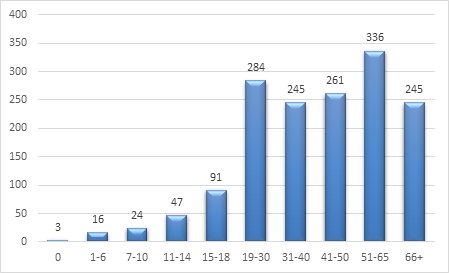
Figure 6. Distribution of patients in the last week by age groups
| Category | Age group | Number of cases men | Share of men (%) | Number of cases women | Share of women (%) | Total by age groups and categories | Share of age groups and categories in the total number of cases (%) | ||
| Kids | 0 | 2 | 66,7% | 1 | 33,3% | 3 | 181 | 0,2% | 11,7% |
| 1-6 | 8 | 50,0% | 8 | 50,0% | 16 | 1,0% | |||
| 7-10 | 11 | 45,8% | 13 | 54,2% | 24 | 1,5% | |||
| 11-14 | 17 | 36,2% | 30 | 63,8% | 47 | 3,0% | |||
| 15-18 | 36 | 39,6% | 55 | 60,4% | 91 | 5,9% | |||
| Adults | 19-30 | 139 | 48,9% | 145 | 51,1% | 284 | 1126 | 18,3% | 72,6% |
| 31-40 | 122 | 49,8% | 123 | 50,2% | 245 | 15,8% | |||
| 41-50 | 122 | 46,7% | 139 | 53,3% | 261 | 16,8% | |||
| 51-65 | 169 | 50,3% | 167 | 49,7% | 336 | 21,6% | |||
| Elders | 66+ | 115 | 46,9% | 130 | 53,1% | 245 | 245 | 15,8% | 15,8% |
| TOTAL | 741 | 47,7% | 811 | 52,3% | 1552 | 100,0% | |||
Table 7. Age and sex distribution of patients in the period from 22nd till 28th of September
Measures
Measures to maintain physical distance, maintain hand hygiene and disinfection are still in force. Also, it is mandatory to wear face masks or medical masks indoors for all health workers and professionals, employees who work in social care system and the ones who work in hospitality facilities.
Headquarters decisions in the previous week:
- Decision amending the Decision about the introduction of necessary epidemiological measures for the area of Ličko-senjska County (October 5, 2020)
- Decision about the introduction of necessary epidemiological measures for the Primorsko-goranska County (October 3, 2020)
- Decision about the introduction of necessary epidemiological measures for the area of the City of Popovača (October 3, 2020)
- Decision about Amendments to the Decision about Introduction of Necessary Epidemiological Measures for the Area of Koprivničko-križevačka County (October 3, 2020)
- Decision about Amendments to the Decision about Introduction of Necessary Epidemiological Measures for the Požeško-slavonska County (October 3, 2020)
- Decision amending the Decision about the introduction of necessary epidemiological measures for the area of Ličko-senjska County (1 October 2020)
- Decision about introduction of necessary epidemiological measures for the area of Šibensko-kninska County (30 September 2020)
- Decision amending the Decision about the introduction of necessary epidemiological measures for the area of Zadarska County (September 29, 2020)
- Decision about amendments to the Decision about introduction of necessary epidemiological measures for the area of Brodsko-posavska County (September 29, 2020)
- Decision about the introduction of necessary epidemiological measures for the area of Vukovarsko-srijemska County (September 29, 2020)
- Decision amending the Decision about the introduction of the necessary epidemiological measure to limit wedding ceremonies for the area of Varaždinska County (September 29, 2020)
- Decision amending the Decision about the introduction of necessary epidemiological measures for the area of područje Dubrovačko-neretvanska County (September 29, 2020)
- Decision amending the Decision about temporary prohibition of crossing the border crossings of the Republic of Croatia (September 29, 2020)
Recommendations and measures on global and EU level
Europe
On 10th of August 2020, ECDC released an updated version of the risk assessment:
- ECDC has additional documents and information available: https://www.ecdc.europa.eu/en, https://www.ecdc.europa.eu/en/covid-19-pandemic
- The number of cases and the 7-day cumulative incidence of COVID-19 confirmed cases worldwide can be found on the ECDC dashboard: https://qap.ecdc.europa.eu/public/extensions/COVID-19/COVID-19.html
Austria
Bundesministerium für Soziales, Gesundheit, Pflege und Konsumentenschutz – https://www.sozialministerium.at/Informationen-zum-Coronavirus/Neuartiges-Coronavirus-(2019-nCov).html
Netherlands
Government of the Netherlands – https://www.government.nl/topics/coronavirus-covid-19
National Institute for Public Health and the Environment – https://www.rivm.nl/en/novel-coronavirus-covid-19Germany
Rober Koch Institut – https://www.rki.de/DE/Home/homepage_node.html
Slovenia
(gov.si) – https://www.gov.si/en/topics/coronavirus-disease-covid-19/
National Institute for Public Health – Slovenia – https://www.nijz.si/en
United Kingdom
gov.uk – https://www.gov.uk/coronavirus
NHS – https://www.nhs.uk/conditions/coronavirus-covid-19/
World
WHO provides comprehensive information and documents
- WHO COVID-19-Dashboard: https://covid19.who.int/
- https://www.who.int/emergencies/diseases/novel-coronavirus-2019
- Coronavirus disease (COVID-19) Weekly Epidemiological Update and Weekly Operational Update i Weekly Surveillance Report: https://www.who.int/emergencies/diseases/novel-coronavirus-2019/situation-reports, https://www.euro.who.int/en/health-topics/health-emergencies/coronavirus-covid-19/weekly-surveillance-report
Sources of information
https://www.hzjz.hr/
https://zdravlje.gov.hr/Information about the global epidemiological situation
More about COVID-19 in other countries can be found and learned on the ECDC website: https://www.ecdc.europa.eu/en/geographical-distribution-2019-ncov-cases. The WHO Regional Office for Europe, the European Commission and the European Observatory on Health Systems and Health Policy have at their disposal the COVID-19 Health System Response Monitor (HSRM). There is information available about European countries and ways to respond to this epidemic. The focus is on health systems and public initiatives: https://www.covid19healthsystem.org/mainpage.aspx
For the latest travel info, bookmark our main travel info article, which is updated daily.
Read the Croatian Travel Update in your language – now available in 24 languages!
Join the Total Croatia Travel INFO Viber community.


